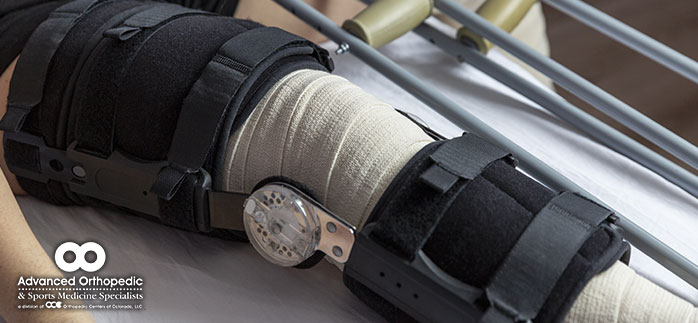When people consider knee replacement surgery, it’s typically because they’ve exhausted other non-surgical treatments, but are still living with pain or mobility issues that are impacting day-to-day life. If this sounds like you, there are a number of key questions to ask before having knee replacement surgery.
There are several types of knee replacement surgery – which one is right for me?
Your orthopedic specialist will help you determine which, if any, of the four main types of knee replacement surgery are right for your situation. It depends on the type and extent of the damage to your knee, and other personal factors. Your surgeon will also evaluate your existing range of motion, stability and your overall strength.
• The most common and comprehensive is total knee replacement, also known as total knee arthroplasty. In this procedure, your surgeon removes the damaged femur and tibia bone and cartilage surfaces and replaces them with artificial material. This procedure may be recommended for patients who have extensive damage or disease throughout the knee joint and are limited in their day-to-day activities by pain and lack of mobility.
• Partial knee replacement – also called “unicompartmental” knee replacement is an option for patients whose injury or damage is affecting only part of the knee joint, and the remaining joint areas are not significantly affected. Our experienced knee replacement surgeons use state-of-the-art technologies including computer-assisted surgeries that allow the procedure to be less invasive and more precise. MAKOplasty, which was first performed in Colorado by Harold Hunt, is one such procedure, which allows the surgeon to resurface only the diseased portion of your knee and ensure that your implants are optimally positioned.
• Revision knee replacement is a special type of total knee replacement that is performed when a previous knee replacement has worn out, is not thriving or performing as hoped, or has loosened in the bone. It’s a more complex procedure because there is less bone to attach new total knee. Although more complex to perform, many patients have good results with this procedure.
• Kneecap replacement (aka patellofemoral replacement) is another partial knee replacement. in this case the undersurface of the kneecap and the groove in the femur are replaced. It typically involves a smaller incision, less disruption to other nearby tissue and thus tends to have the fastest recovery time.
How do I prepare for knee replacement?
Preparation for knee replacement involves physical, mental and organizational aspects of your life. Physically, it always helps to be in the best shape and health that you can be. Your doctor will want to know if you have any serious health conditions like diabetes or heart disease and will encourage exercise and a healthy diet. The good news is you can impact your physical health in a relatively short amount of time and may need to improve your diet and work on leg strength – particularly your quadriceps – before having surgery.
Mental preparation includes a personal commitment to pre and post-surgical care from pre-op exercise to post-op physical therapy. By committing to do the work every day, being patient and realistic with your recovery timeframe and outcomes, you will be better positioned for a positive experience.
Lastly, being prepared means having plans and equipment for post-operative care and rehabilitation. This includes help from family and friends, ice packs, perhaps a walker and help getting around in the first few weeks after knee replacement. Patients should prepare their home to be as accommodating as possible. Depending on your home set up, this may include moving your sleeping area to the main floor, removing any obstacles or clutter that could make it difficult to navigate your space and setting aside an area that is safe and comfortable to spend time in while you recover.
What is the recovery time for total knee replacement surgery? For partial?
Even for a full knee replacement, your doctor will likely have you up and moving as soon as possible after surgery, within a few hours of the procedure. It’s essential to get the joint moving and begin the rehabilitation process to minimize scar tissue and maximize long-term range of motion.
Within a few weeks – as soon as 2 weeks for partial, and three-six weeks for total knee replacement – most people are able to return to many daily activities including driving, as long as you are not taking pain killers, and have the range of motion and muscle control to safely operate a vehicle. At this point many low-impact activities are in play too, but it typically takes more time to be active in sports like running, skiing and tennis. Your orthopedic team will work closely with you to map out a recovery plan that includes therapy and exercise.
What does a “full recovery” look like? Will I be able to return to the activities I love?
Regardless of the type of surgery, knee replacement is intended to improve mobility and reduce pain, ultimately allowing for more independence and better quality of life. It’s important to remember that outcomes are unique to each individual. A successful outcome can mean many different things depending on the amount, type and source of damage pre-surgery; your physical fitness level, overall health and age, and your personal goals among other things.
It’s important to understand the range of likely outcomes for your personal situation before you say yes to surgery of any kind, so that you can ensure that the time and effort will result in your best outcome.
The bottom line
Talk with your doctor to ensure you understand the potential risks and rewards of knee replacement surgery, and if there are any non-surgical treatments that might provide relief. Do your homework on your surgeon, the type of surgery that’s been recommended and your role in a successful outcome. Have questions about knee replacement? Talk to one of our specialists.

















